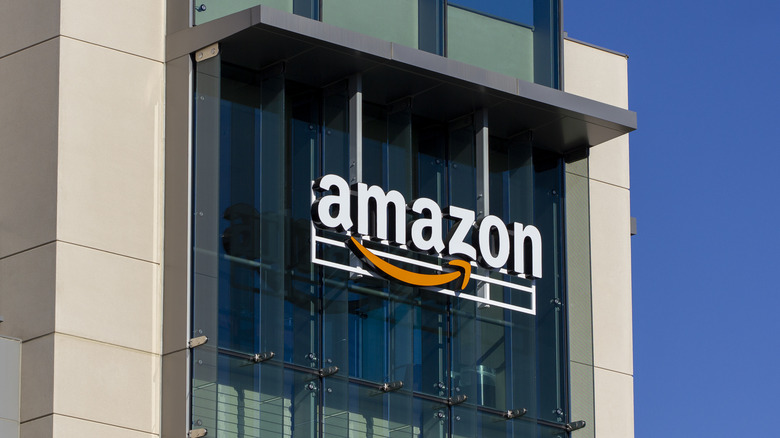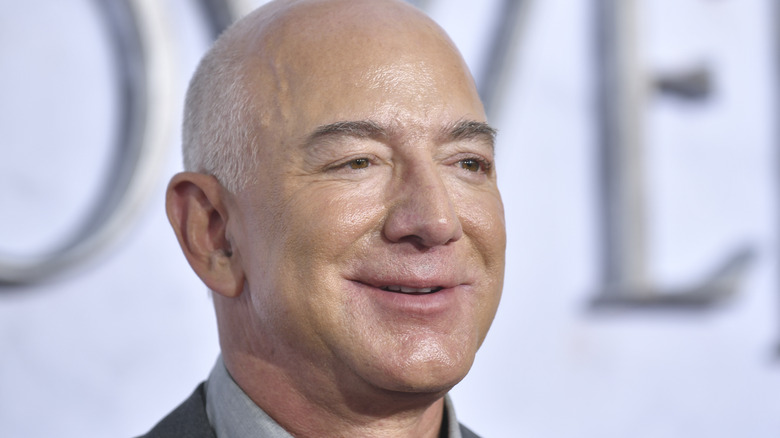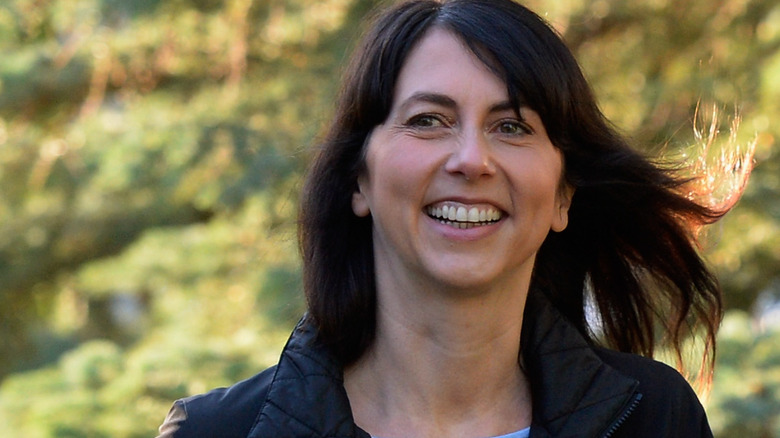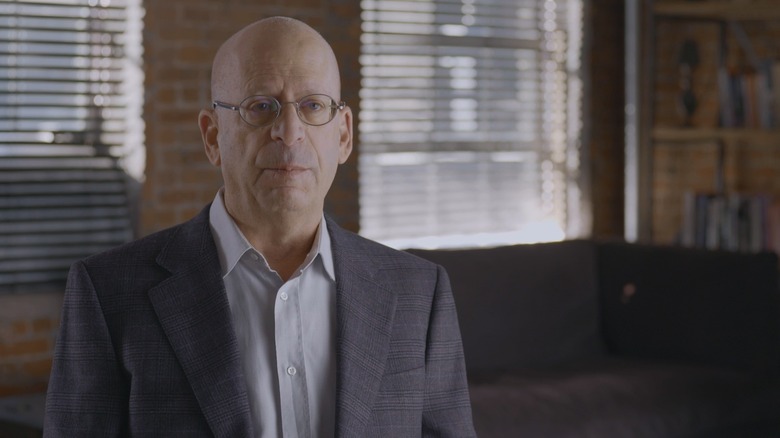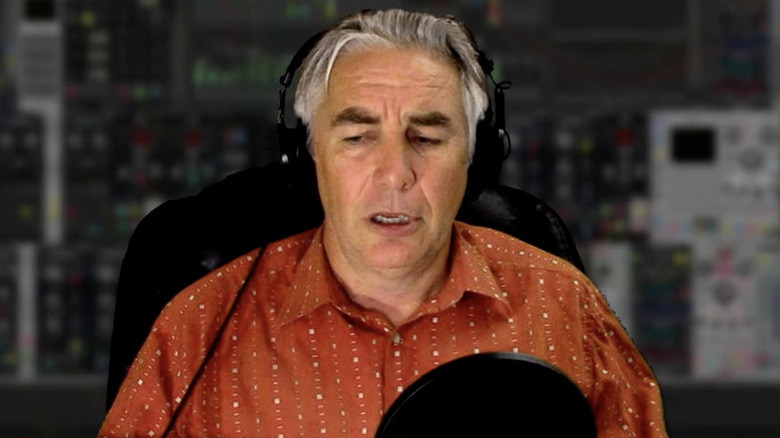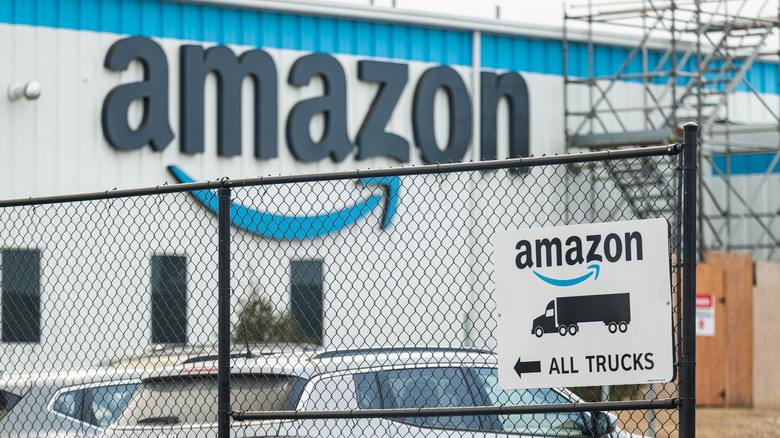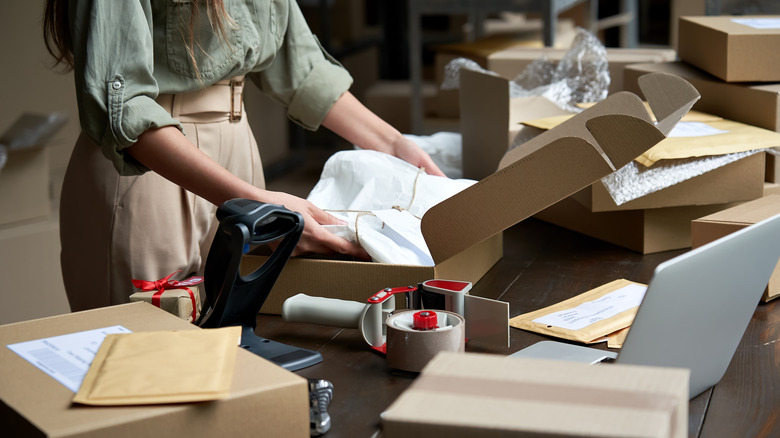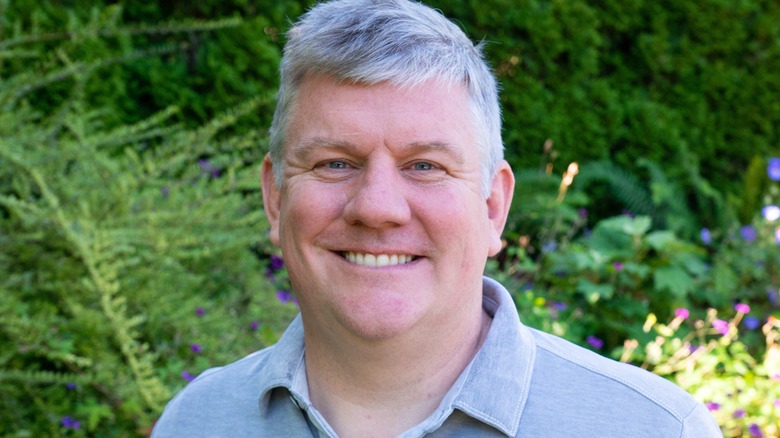This Is What Amazon's First Employees Are Up To Today
If you were an Amazon customer in its early days in the 1990s, it would have been hard to imagine what it's become over the years. What started as an online bookstore, leveraging the ability to stock more titles than even the biggest physical stores, logically expanded to music and movies during the early years before eventually turning into "the everything store." Well, maybe some of that could be predicted, as Amazon was ahead of the curve in terms of managing a massive inventory online.
What couldn't have been predicted was the degree of growth and the other products and services that came with it. These days, Amazon is a consumer tech hardware company, an enterprise web services company, a streaming music and video powerhouse, a TV/movie studio, and more. It made its founder, Jeff Bezos, one of the world's richest men (at times the richest), and his ex-wife, MacKenzie Scott, one of the world's richest women (at times the richest) until she started unloading billions to charity.
As a way of examining that growth, let's flashback to the early days of Amazon and some of its very first employees. What did they do at Amazon, how and why did they leave, and what are they doing now?
Jeff Bezos
Jeff Bezos was working in the financial sector in New York City when he decided to found Amazon as an online bookstore in 1994, which he officially launched on July 16, 1995. "I came across the fact that web usage was growing at 2,300% per year. I'd never seen or heard of anything that grew that fast, and the idea of building an online bookstore with millions of titles — something that simply couldn't exist in the physical world — was very exciting to me," recalled Bezos in his commencement speech for the 2010 graduating class of Princeton University. He told his wife that he wanted to quit his well-paying job to gamble on this; she gave him the proverbial thumbs up, and Amazon.com was born.
Though Bezos has long spoken of Amazon being run out of his garage and taking the books to the post office himself in those early days, it's unclear exactly how much of that is legend or exaggeration, like the garage simply being the office space. Pretty much from the beginning, Amazon was touting a book catalog that ran one million titles deep, so the company clearly had a large warehouse by then. Regardless of how much faux humility he has tried to show, the idea clicked: Amazon grossed $15.7 million in its first 18 months and parlayed that into going public in 1997, raising $54 million in the process.
In 1998, Amazon started selling music, and in 1999, it started turning into "the everything store," which customers had requested in a 1997 survey. From there, Amazon became a snowball rolling downhill, with Bezos now worth over $150 billion. Bezos stepped down as Amazon CEO to concentrate on curiously-named aerospace company Blue Origin in July 2021.
MacKenzie Scott (formerly Bezos)
MacKenzie Scott, Jeff Bezos's wife for most of the Amazon journey to date, wasn't just the founder's spouse. In the early days, she served as the company's accountant/bookkeeper, but her role was certainly bigger than that. In a lengthy Wired profile of Jeff Bezos that the magazine published in 1999, it's noted that she negotiated Amazon's initial freight contracts, albeit in a Starbucks store.
"She was clearly a voice in the room in those early years," Brad Stone, author of "The Everything Store," told The New York Times in 2019. "Business wasn't her passion, and when Amazon took off, she wasn't as involved in the day-to-day business." At that point, she switched her focus to raising her and Jeff's kids, philanthropy, and, at times, writing novels. Aside from promoting her books, Scott mostly stayed out of the public eye, but media scrutiny on her increased in 2019 when she and Bezos got divorced, both in general and because there was no prenuptial agreement.
"Both historically and today, it takes a lot more 'proof' for a woman to claim competence, importance, and intelligence — something we see powerfully played out on the national political stage every day, from Hillary Clinton to Alexandria Ocasio Cortez," technology historian Marie Hicks told Wired in 2019. "It seeps into how we talk about women associated with tech on an everyday basis, whether it's at work, at school, online, or in the media."
Though no longer the world's richest woman, she's still worth over $35 billion as of this writing. She focuses on philanthropy and has given away so many billions in such short order that it was notable how much of an outlier her degree of generous giving has been since the divorce.
Shel Kaphan
Shel Kaphan was the first employee hired by Amazon, starting in 1994 as vice president of research and development and leaving in 1999 after being promoted to chief technology officer. he was pivotal in building the company's technological infrastructure. In an interview for Achievement.org, Jeff Bezos once dubbed Kaphan "the most important person ever in the history of Amazon.com" for "[building] all of our early systems."
"He had help from others, but he was the architect; he engineered them and just did a fantastic job," Bezos added. Among other things, the aforementioned book, "The Everything Store," notes that Kaphan was part of the development of Amazon's "1-Click" ordering technology at a time when asking an internet retailer to hold on to your credit card information was unheard of.
In a 2011 interview for GeekWire, his first of note in the dozen years since leaving Amazon, he explained some of his reasons for leaving. "Two and a half years into the company, they hired two other tech managers, and basically, my job was divvied up between the two of them," he recalled. "I was transitioned to being CTO and still in charge of architecture. But right away, the projects that the new managers were doing were having significant architectural effects that I was not involved in overseeing, being able to say no to anything or ... instigate anything. I basically felt that I had been sidelined. There are other things that I probably don't want to talk about."
That more or less wrapped up a 25-year programming career, with Kaphan largely devoting his time to his charitable foundation and occasional consulting work since then. More recently, in a "FRONTLINE" documentary for PBS, he expressed concerns that Amazon needs to be broken up into different companies.
Paul Davis
After Shel Kaphan, Paul Davis was the next hire at Amazon. Though he didn't last particularly long, leaving in 1996, he was an important member of Kaphan's back-end development team. To describe exactly what he did and why he left, the best place to start is probably his old CV/resume, which the Wayback Machine lists as being online by June 2003.
"I was the second employee at the company and one of the two technical staff responsible for designing and implementing the software engines that support the bookstore's early presence on the Internet," he wrote. "Specific components that I developed included: a complete C/C++ programming interface to Oracle's RDBMS, an 'almost in time' order processing and tracking system, a completely new concept in mail order handling, a pseudo-natural language for book searching, Amazon.com's secure credit card system, [and] the 'Eyes' book notification service. I was intimately involved with many aspects of getting this new company started."
As for his departure, Davis wrote, "I left, despite significant stock and other inducements to remain, because I am a technical person and had little interest in playing a role in the growth of the company." In 1998, he founded Linux Audio Systems, where his LinkedIn page says he's worked ever since. Just like Kaphan, he expressed concerns in a December 2019 interview for Recode that Amazon should be broken up. More specifically, he cited the company's habit of undercutting successful Amazon Marketplace sellers by knocking off their products.
"They're not breaking any agreements," he explained. "They're just violating what most people would assume was how this is going to work: 'I sell stuff through your system [and] you're not going to steal our sales.'"
Eric and Susan (and Rufus) Benson
Married couple Eric and Susan Benson joined Amazon in 1996 as an engineer and the company's editorial director, respectively, and lasted about five years, leaving in 2001. They were working for Netscape when Shel Kaphan started wooing them to the new online book vendor in 1995. Kaphan didn't know until 20 years later, though, that Susan played a pivotal role in Amazon's growth even before she started working there.
"I had worked with Eric in three different places by then," Kaphan told YCombinator in the aforementioned 2016 interview. "We had a 'friends and family' soft launch in the spring of '95. They were among the people that were trying it out. We later hired both of them at Amazon. Susan was working on Netscape's website in an editorial capacity. I only learned this last year, but when we opened up to the public, it was she who put Amazon on their 'What's New' and 'What's Cool' pages. She put us on those lists. Then, because the name started with an A, it was above the fold, so lots of people saw it. That was, in my opinion, a super important connection for us. It might have happened without the personal connection, but who knows, maybe not."
Eric, meanwhile, worked on Amazon's recommendations engine that would quickly become a huge part of the website's user experience. There was also a third Benson at Amazon in a less official capacity: Their dog, Rufus, died in 2009 but lives on forever as the mascot whose photo you see on Amazon error pages.
Tom Schonhoff
Tom Schonhoff was Amazon's fifth full-time employee, and based on what he told Business Insider in 2017 for a story that eventually ran in 2020, he was pivotal in setting up the company's customer service department. In Amazon's early months, not only did Schonhoff establish what the article describes as "Amazon's famous 'it's all about the customers' attitude," but he also dropped off packages of books at the post office to make sure they went out to customers as soon as possible.
Schonhoff's customer service duties could take him on some peculiar adventures at times. According to one memorable excerpt from "The Everything Store," that included trying to figure out why a fulfillment center in Delaware stood out as having a poor group of temps. "There were a lot of temp workers that looked like the rehab center had pushed them out the back door," he recalled, also noting how he saw one temp fired for being intoxicated at work, only for said worker to wet himself while trying to fight for his job.
It took a week, but Schonhoff's team (figuratively) cleaned up the facility. "We worked with sincerity and diligence," he added. "Can I say that without sounding like an ass? The goal was to get Christmas out the door and uphold our brand promise. We believed in it."
It's not entirely clear when or how Schonhoff left (and potentially returned to) Amazon, in large part because he keeps a very low profile. Other articles about Amazon's early staff give conflicting dates, but his name is on some of the company's patent filings as late as 2014. Public records and a 2015 article in Crain's New York Business also peg him as being one of the founders of the now-defunct delivery service Lunchola.
Nicholas Lovejoy
Nicholas Lovejoy has also been dubbed Amazon's fifth employee for whatever reason, so maybe everyone just stopped keeping track early on. Most famously, he's credited with an early tweak that dramatically increased fulfillment center productivity and made Jeff Bezos "how stupid I can be." In a 2017 speech, Bezos recalled observing how much physical difficulty he and a fellow warehouse employee were having with packing boxes on the floor when he had an idea.
"I said to the person next to me: 'This packing is killing me!'" he recalled. "'My back hurts; this is killing my knees on this hard floor.' The other person says, 'Yeah, I know what you mean.' And I said, 'You know what we need?' — and this is my brilliant insight — 'We need ... kneepads!' And I was very serious! This person looked at me like I was the stupidest person they'd ever seen. They're like, 'I'm working for this person; this is great.' And he said, 'What we need is packing tables.' And I looked at this person and ... thought that was the smartest idea I'd ever heard! The next day, we got packing tables, and I think we doubled our productivity."
That other person, as you've probably deduced by now, was Nicholas Lovejoy, who worked with Bezos at the hedge fund he left to start Amazon and left a job as a math teacher to join him. He helped build the logistics side of the company before cashing out after the company went public and subsequently devoting his life to philanthropy. He did return in some form in 2016 to help run Amazon Transportation Services, though.
Mike Hanlon
Mike Hanlon was Amazon's seventh employee, working there from 1995 through 2001. According to his LinkedIn page, his job was to manage operations for the business and software development teams. "From 1995 to 1997, I managed real estate operations and wholesale book ordering and administered UNIX and telecom systems," he wrote. "I also packed a lot of books. In 1997, I served on the business development team as Amazon.com expanded to new products and international markets. From 1998 to 2001, I was a software engineer, developing applications for the finance and customer service teams."
In the aforementioned Business Insider article, Hanlon relayed a particularly amusing anecdote about the kind of shop that Jeff Bezos ran in the early days. "During Christmas 1995, the site really took off," he recalled. "Everyone was working long hours, and my girlfriend (now wife) Molly would come hang out in the warehouse in the evenings to help us pack up shipments. That was really the only chance that Molly and I had to see each other, and her help enabled us to get home earlier than we would have otherwise. When Jeff Bezos realized that Molly was helping us in the warehouse, he came down and had her sign a non-disclosure agreement."
Post-Amazon, Hanlon's main focus was two companies he founded, both named Abett. The first, which he ran from 2014 to 2017, was, as described on his LinkedIn page, "a social platform that gave consumers data-driven recommendations free from the influence of advertising." The second, which he's run since April 2018, is a software services company that provides secure solutions for migrating benefits data and other human resources data. As of November 2022, he's raised $12.1 million in funding for the company.
